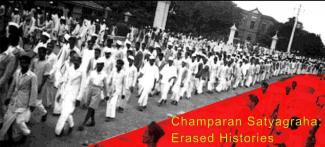
[As in the case of Chauri Chaura, the “official” centenary celebrations of the Champaran Satyagraha erased and manipulated history to suit ruling class interests. Excerpts from a write-up by historian Mohammad Sajjad in the May 2017 issue of Liberation.]
In 2017, the provincial government of Bihar chose to celebrate centenary of the Champaran Satyagraha. By funding a lavish academic seminar, it also chose to commemorate some of the leaders of the peasants as well as the companions of Gandhi who was persuaded to intervene into the issue; such sarkari events also felicitated some of the heirs of the peasant leaders, who have remained relatively lesser known in the better known books on the history of Champaran Satyagraha. This is despite the fact that the significant memoirs, diaries and correspondences of the better known leaders of the movement have either omitted or downplayed some of the significant names associated with the Satyagraha. Not only this, such accounts have also tried to conceal certain important facts about the class/profession characters of some of the leaders.
For example, the Collected Works of Mahatma Gandhi (CWMG), vol. 15, deals with Gandhi’s stay in Patna and Muzaffarpur, on his way to Champaran in April 1917; subsequently, in January-February 1929, once again Gandhi recollects the details of his initiatives and correspondences about the Satyagraha of 1917, and gives details about all these in CWMG, vol. 44. In both these accounts as well as in his autobiography, there is no mention of Batakh Miyan Ansari (1867-1957), who had saved the lives of Gandhi, and of Dr Rajendra Prasad, who was accompanying Gandhi in 1917 to Champaran. This significant episode finds no space whatsoever in the accounts of Rajendra Prasad, not even in the memoir, My Times: An Autobiography, of Acharya J. B. Kripalani (1888-1982) which was written in the 1970s, long after the British had gone, and was published, in 2002. Pir Mohammad Ansari ‘Munis’ (1882-1949) has been acknowledged by Rajendra Prasad, very sparingly, and by Gandhi not at all. Munis, (son of a toddy seller, named Fatingan Miyan), managed to get a smattering of education in Nagri-Hindi. That was an era when primary and secondary education in Persian was almost a mainstream. Rajendra Prasad (1884-1963) and many more of such figures went to maktabs and received their education in Persian. Despite this fact, from the late 19th century onwards, the Hindi-Urdu dispute acquired overtones of a Hindu-Muslim conflict as well. In this scenario, Munis emerged as a Hindi writer and graced the sessions of Hindi Sahitya Sammelan. Rather than writing for the religious identity he could be identified with, he chose to fight for his class identity. This in itself awaits historical exploration even while some of the towering nationalists have largely chosen to almost erase him out of the narratives. Acknowledgements of the roles played by the peasant leaders like Shital Rai, Haribansh Sahay, Sheikh Gulab (1858-1943), Sheikh Rajab Ali, and many such leaders remain inadequate even in the proverbial footnotes and margins.
Even the more acknowledged name of Rajkumar Shukla (1875-1929), raises some serious questions as to why did the accounts of Gandhi, Rajendra Prasad, Kripalani, etc., conceal the fact that Shukla was a moneylender who earned around 1600-2000 a month from interest out of the money-lending. This is a fact stated by Shukla himself while deposing before the enquiry which was conducted by Gandhi himself. Incidentally, even in the sarkari felicitation of 2017, the government of Bihar once again forgot to call the heirs of Batakh Miyan.
A few more questions emerge about the historiographies of the Champaran Satyagrahaa. Why did Gandhi and his companions, the upper caste urban advocates of Patna and Muzaffarpur, as well as the likes of Shukla, leave the suffering peasantry of Champaran in the lurch? Why did Gandhi and the Congress choose to target the European Indigo planters of Champaran, but leave out the more exploitative Opium zamindars?
Thus, erasure of such poor subaltern people from ‘official’ accounts, endures even during the official centenary celebrations. One may defend it by arguing that all these erasures in 1917, and in 2017, happened unwittingly. But how strong would such a defence really be?
The peasantry, the disadvantaged and oppressed classes and the progressive forces need to recall the histories of Champaran Satyagraha and of the Naxalite Movements in these ways rather than being deceived and cheated by the official celebrations where erasures of the brave histories of the subalterns and of the exploited sections and their leaders are being perpetuated as consciously now, as it was in the colonial era.
Liberation Archive
- 2001-2010
- 2011-2020
-
2021-2030
-
2021
- Liberation, JANUARY 2021
- Liberation, FEBRUARY 2021
- Liberation, MARCH 2021
-
Liberation, April 2021
- Golden Jubilee of the Independence of Bangladesh
- Modi Regime’s Latest Assault on Federalism and Democracy
- The Challenge of Saving West Bengal from Fascist Takeover: Liberation's Reply to PD Commentary
- Dhikkar Diwas Observed in Bihar: MLAs Brutally Beaten Inside Assembly, Police Raj Act Forcibly Passed
- Resisting The BJP Threat In West Bengal: Examining PD’s Arguments
- The Tightening Noose of Fascism and the Rising Tide of Protests
- Growing Repression Begets Stronger Resistance And at the End of the Day, the People Wins
- Anti-Privatisation Day Observed All Over India
- India’s Draconian Lockdown: One Year Later
- The Past That Shines A Light On Our Present
- Chauri Chaura Centenary: Rescuing History From Saffron Misrepresentation
- Champaran Satyagraha: Erased Histories
- Remembering Swami Sahajanand: Excerpts from Flaming Fields of Bihar
- How Bihar’s Peasants Chose to Honour Sahajanand
- Solidarity with the people of Haiti : in their struggle for democracy, justice, and reparations
- Nawal El Saadawi
- Sagar Sarhadi
- Liberation, May 2021
- Liberation, JUNE 2021
- Liberation, JULY 2021
- Liberation, AUGUST 2021
-
2021
Charu Bhawan, U-90, Shakarpur, Delhi 110092
Phone: +91-11-42785864 | Fax:+91-11-42785864 | +91 9717274961
E-mail: info@cpiml.org




